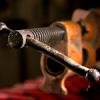I find the shooting board really convenient and I use it all the time.
For me, it's much like a bench hook in that it provides a simple way to hold a board and plane in order to square the end, or trim the length by very small increments. When cross cutting, I almost always create a knife line whether make the cut with hand saw, table saw or occasionally the miter saw.
It's become routine for me to make a cut and then take a few strokes on the shooting board to get down to my line. It also encourages me to make more cuts with a hand saw because I can easily clean up cuts that wander off a bit.
FWIW, my shooting board is made from some MDF, plywood and a scrap piece of oak. I was all left-overs but the retail value is probably less than $10. Also, since I made the shooting board perfectly square and the plane is set correctly I end up ends that are perfectly square in both directions every time.
Last edited by Daniel Rode; 10-13-2014 at 3:54 PM.
-- Dan Rode
"We are what we repeatedly do. Excellence, then, is not an act, but a habit." - Aristotle





 Reply With Quote
Reply With Quote









